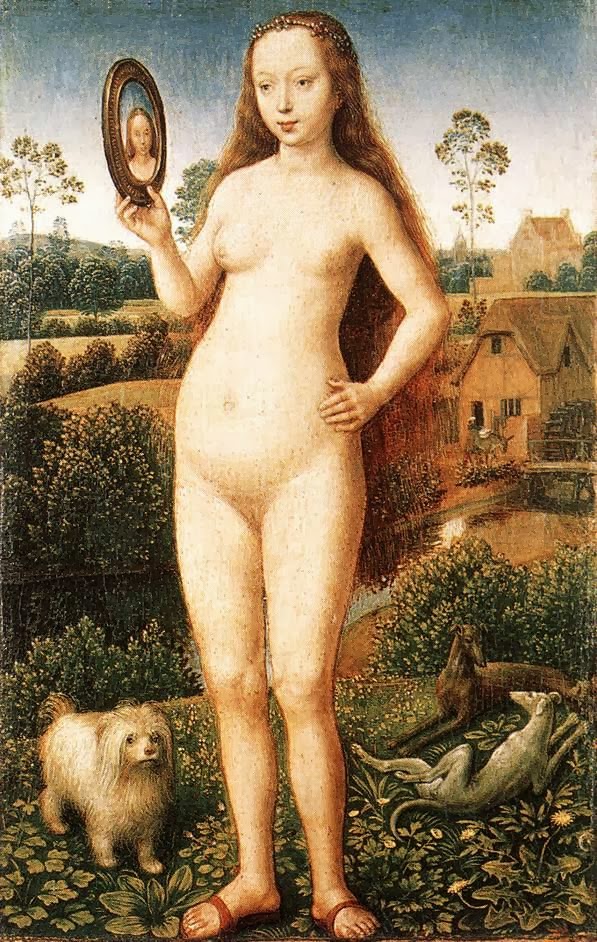'According to usage conventions which are at last being questioned but have no means been overcome - men act and women appear. Men look at women. Women watch themselves being looked at'
Hans Memling - Vanity - 1485
Mirror - because she is looking at herself it is OK for us to look at her.
Painting a nude because he enjoys it.
At a time of harsh judgement of women - witch hunt.
Mirror device appears in contemporary advertising and fashion photography.
Still cannot see eyes - she is preoccupied looking at herself.
Gives us permission to look and admire her without interuption.
Voyeristic.
Alexander Cabanel - Birth of Venus - 1863
Invited to look at the image, by both the women and artist.
Seen by hand covering eyes.
Sophie Dahl for Opium
Deemed too riske and was then rotated horizontal to change focus to the face.
Titan - Venus of Urbino - 1538
Invitation to look at her body.
Positioning of the hand - covering or sexual.
Compared to Manet - Olympia - 1863
Directly addresses us.
Challenging the gaze.
Looking directly at us.
Very different meaning to the hand - completely covering her.
Manet celebrating powerful female figure.
Ingres - Le Grand Odalisque - 1814
 Guerrilla Girls - Controversial reproduction to challenge womens role in art.
Guerrilla Girls - Controversial reproduction to challenge womens role in art.Manet - Bar at the Folies Bergeres - 1882
Use of mirror - does not show correct image.
Put in the position of the painter/viewer.
Behind her is the Paris society that she is not part of.
Disaffected manner.
Jeff Wall - Picture For Women - 1979
Same inactive look.
Mirror wall divided into thirds.
Focus on the camera.
Wall seperated himself from the female figure.
Complex use of space.
Refers to Manet's previous painting.
Set up rather than put in.
Coward, R. - 1984
The camera in contemporary media has been put to use in an extension of the male gaze at women on the streets.
Use of sunglasses - she is prevented from returning our gaze.
Eva Herzigova - Wonderbra - 1994
No return of gaze.
Coward, R. - 1984
The profession of images which characterises contemporary society could be seen as an obsessive distancing of women... a form of voyeurism.
Peeping Tom - 1960
Objectification of the male body.
Again no return of the gaze.
Dolce & Gobanna Advert
Marilyn: William Travillas dress from The Severn Year Itch - 1955
How images are cut up.
Viewed close up.
Detaches us from the character/actress.
Females never the drivers.
Suggests that cinemas and theaters are sexual havens where you can watch and not be seen.
The active male role and the passive female.
Artemisia Gentileschi - Judith Beheading Holofernes - 1620
Griselda Pollocks - Old Mistress
Women 'margionalised within the masculine discourses of art history.'
Cindy Sherman - Untitled Film still #6 - 1977-79
Partially clothed women.
Mirror face down on the bed - denying us the narritive to gaze upon her.
Hand raised to the head - staged.
Challenging the gaze.
Barbara Kruger - Your Gaze Hits The Side of My Face - 1981
Violent reference.
Sarah Lucas - Eating a Banana - 1990
Self Portrait with Fried Eggs - 1996
Tracey Emin - Money Photo - 2001
Why is it important to challenge the gaze:
We still have Page 3
Caroline Lucas MP in June 2013
Criado-Perez
Received up to 50 threats a day.
Reinstated the women on the £5 note.
Women are removed from history.
Social Networking is used to perpetuate the male gaze/the gaze of the media.
Susan Sontag - On Photography - 1979
Role of the Paparazzi
Reality TV
Appear to offer us the position of power.
The power of gaze.
Allows a voyeuristic passive consumption of a type of reality.
editing means that there is no reality.
Contestants are aware of their representation.
The Truman Show - 1988
Born into a reality TV show.
He his the only one who doesn't know.
'Looking is not indifferent. There can never be any question of 'just looking''















No comments:
Post a Comment